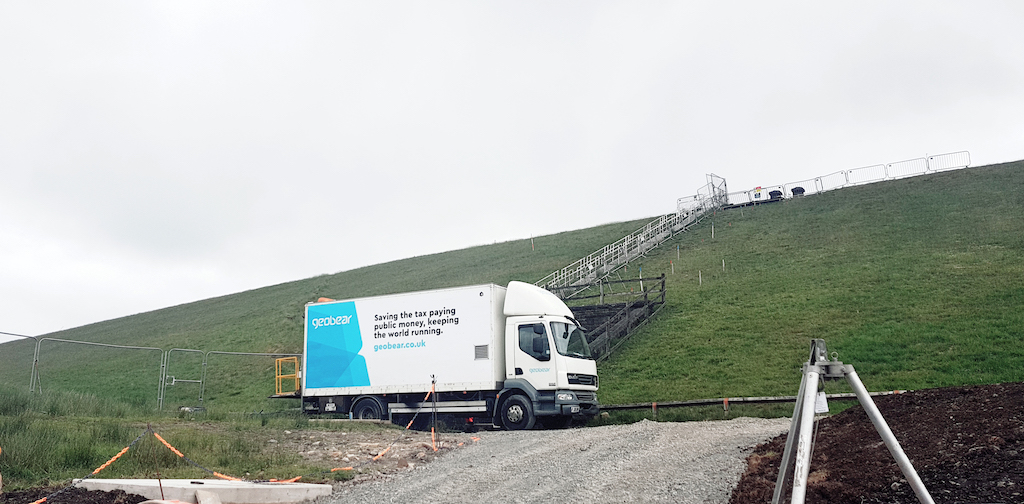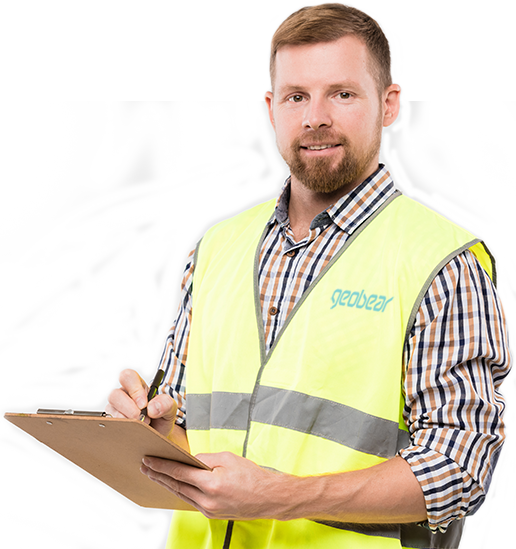We all have a responsibility for the environment and Geobear is no different. Our solutions have been assessed by Carbon Footprint Ltd and are certified to emit significantly less carbon in comparison to traditional methods.
One recent study found using a Geobear approach to asset maintenance in the rail sector could lead to a 75% reduction in carbon emissions. This study was in relation to a railway level crossing and compared a complete reconstruction to Geobear’s asset maintenance solution. When the solution is scaled to other assets, the carbon reduction in maintenance of railway assets is quite staggering. We are leading the way in driving the transition to low carbon solutions across the industry. We join the government and infrastructure maintainers in seeking alternative approaches to asset maintenance and playing our part in responding to the climate emergency.

Geobear is fully committed to the environment and sustainability, operating a robust Environmental Management System (EMS) that will be certified to ISO 14001 this year. The EMS is integrated with our Quality and Safety Management Systems. Environmental risks are identified through site visits, desk studies and where necessary specific investigations (e.g. ecological surveys for protected species or structural inspections of listed structures) prior to works commencing on site.
Depending on the project size and scope an environmental impacts checklist or a full stand-alone aspects and impacts register will be developed by our Manager or SHEQ Director respectively. This includes aspects such as archaeology, historic structures, SAM, Conservation Areas, protected and invasive species, controlled waters, GWPZ and contaminated land. Identified Impacts are documented and highlighted to the engineering team to enable mitigation at the design stage.
Following the completion of the design additional control measures are then included in the site-specific RAMS and the Construction Phase Environmental Plan to address any outstanding impacts. All employees at Geobear receive specific environmental training to ensure that they understand what our environmental aspects and impacts are, as well as the required control measures to mitigate these. Most training is delivered in-house. It is developed by our SHEQ Director to be fully relevant to our daily activities. All training requirements and records of delivery are held on our training and competency registers. Where specialist training is required, accredited external companies are utilised (e.g. Approved Environmental Auditor training).
We also assess our operational impact in relation to wider sustainability issues. We have externally verified our carbon footprint to understand our impact. Due to our innovative approach to construction activities, our footprint is predominantly transport-related and we are evaluating ways to reduce this. Where works are suitable for execution using our Geopolymer systems these solutions can significantly reduce the carbon footprint of a
project. For example, geopolymer stabilisation of an embankment can reduce the carbon footprint by up to 90% compared to a traditional grouted solution.
Resource efficiency is a priority for Geobear and is included within our EMS. We aim to optimise the purchase of sustainable options (e.g. FSC timber). We have also provided training to all staff on wider sustainability issues to enable them to make effective decisions. Efficient resource management is embedded in our operational processes as it is simply good business practice.
Continual improvement is a cornerstone of our approach to operational delivery and innovation. Our improvement idea award process, enables employees to submit suggestions for improvements to anything related to our activities, including environmental improvement ideas.
Any environmental challenges arising on a project are discussed at the Operations Meeting and the Management Team Meeting. Trends are identified in relation to Environmental Hazards, Incidents, Inspections, Audits and Near Misses. Any required actions to improve performance are determined, implemented and monitored.
The EMS was developed in house by our SHEQ Director, who is a Chartered Environmentalist. She holds a degree in Environmental Science and a Masters in Environmental Management, as well as being a full member of IEMA and a registered Principal Environmental Auditor. With twenty years of experience in the environmental field, we are confident that we have the required expertise in-house. We also make use of a range of specialist consultants e.g. ecologist, archaeologist, conservation professionals who support the development of our solutions for specific Projects.

Geobear has worked on a number of contracts within environmentally sensitive areas including sites of special scientific interest. An example of works in an SSSI is Cobbinshaw Reservoir, a project Geobear undertook in 2020 for Scottish Canals.
Cobbinshaw Reservoir is a site of special scientific interest (SSSI) located in West Lothian, Scotland. For several years, the reservoir had suffered water leaks from a discharge chamber following the installation of siphon pipes in 2013. The estimated leakage was 500m3 /day. Scottish Canals manage the reservoir, and they had a responsibility to investigate and control the leakage.
The investigation was undertaken by Scottish Canals Technical Manager who designed some remedial works to try to abate the flow. Initial works centred around the slab joints which they thought could be the problem. The joints were replaced; however, upon refilling the reservoir, the leakage flow continued. It was concluded that the leak could only be occurring at the joints of a supporting wall that lay beneath a 250mm concrete slab and adjoined the old weir to the new siphon wall. Scottish Canals approached Geobear to propose a solution.
Geobear’s Geopolymer has been subject to extensive environmental testing and is leachate free and has no impact on aquatic eco-systems. Furthermore, the rapid curing of the material (less than 60 seconds) means that there is minimal risk of any leakage during the injection process. The installation system is fully self-contained and lorry mounted with a 70m hose which runs from the lorry to the injection location. This means there is no requirement for enabling works prior to carrying out the injection process. Using our geopolymer injection process meant that the water level only needed to be reduced minimally to access the work area. The non-invasive method also meant only small drill holes were required through the slab and this would not impact its integrity.
We proposed treatment to 2 metres below the slab and back up to the underside of the slab. This was easily accessible using Geobear’s small diameter injection tubes. On the day of the works, the exposed site was hit with unseasonable weather; however, with the requirement for minimal plant, the Geobear technicians were able to improvise to maintain a clear working area. Injections were completed adjacent to the ends of the supporting wall. The flow of the geopolymer through the silty clay fill below the slab, with its controlled expansion and rapid curing time, provided instant results that the client was hoping for. The continuous flow of water through the shutter holes into the siphon chamber gradually slowed and finally stopped a matter of minutes following the final injections taking place. Scottish Canals have a legal requirement to inspect the reservoir weekly and, to date, no further reports of leakage recurring have been made.
Geobear has extensive experience of working on numerous contracts involving works in a historic environment. A recent example of a project undertaken in accordance with the requirements of BS7913 was at Seaton Delaval Hall.
Seaton Delaval Hall is a Grade I listed country house on the coastline in Northumberland, England. It was designed by Sir John Vanbrugh in 1718 for Admiral George Delaval, now owned by the National Trust and more recently opened to the general public.
Over many years the soils beneath the property had compacted and washed out in places this had caused particular issues to the foundations to the west wing of the historic house, where significant cracking and movement both internally and externally to the property has been present. Site investigations revealed various treatment depths ranging between 1.5m to 7.0m below ground level. A solution was required that would remediate the soils without any excavation or damage to the historic building.
“We employed Geobear Ltd as the hall is undertaking a significant restoration programme and as such, Geobear offered the best-suited option for the stabilisation works. Through their programme, work areas were kept clean and tidy and enabled other trades to work in the vicinity, which in turn allowed our programme not to be delayed”.


All terms of use are certified. Copyright. Geobear 2023.